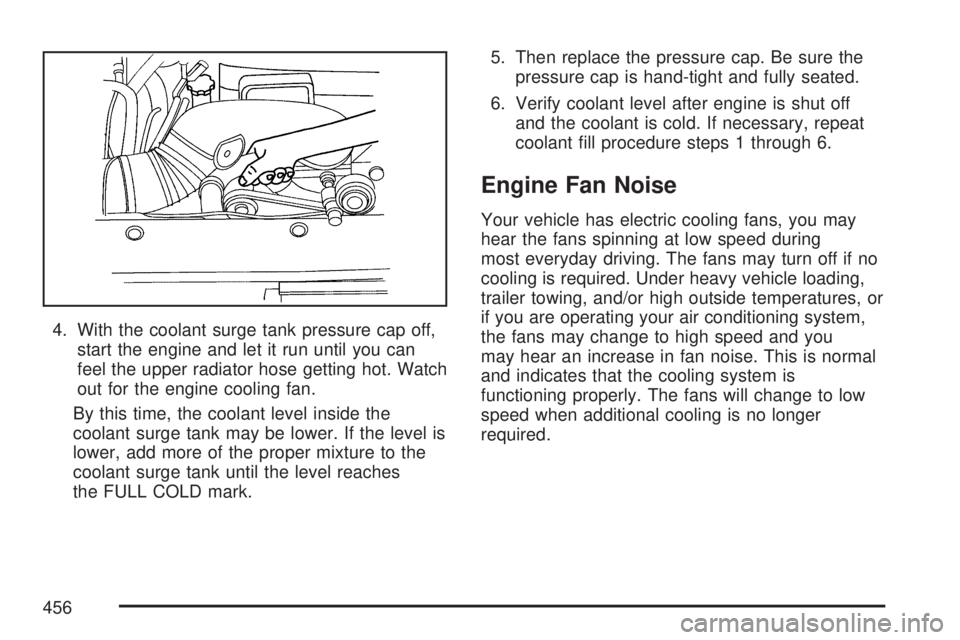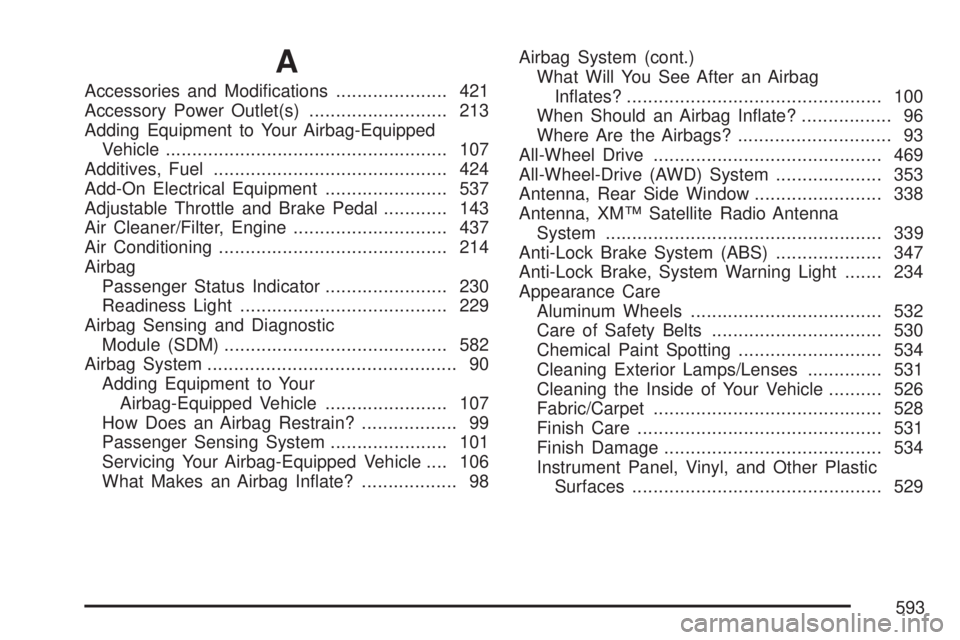2007 GMC YUKON XL DENALI air conditioning
[x] Cancel search: air conditioningPage 254 of 608

ENGINE HOT A/C (Air Conditioning)
TURNED OFF
This message will display when the engine coolant
becomes hotter than the normal operating
temperature. SeeEngine Coolant Temperature
Gage on page 236. To avoid added strain on
a hot engine, the air conditioning compressor
automatically turns off. When the coolant
temperature returns to normal, the air conditioning
compressor will turn back on. You can continue
to drive your vehicle.
If this message continues to appear, have the
system repaired by your dealer as soon as
possible to avoid damage to your engine.
ENGINE OIL LOW ADD OIL
If your vehicle has an oil level sensor and the oil
level in the vehicle is low, this message will
display. Check the oil level and correct it as
necessary. You may need to let the vehicle cool
or warm up and cycle the ignition to be sure
this message will clear.
This message will clear itself after 10 seconds,
until the next ignition cycle. SeeEngine Oil
on page 432for additional information.
ENGINE OVERHEATED IDLE ENGINE
Notice:If you drive your vehicle while the
engine is overheating, severe engine damage
may occur. If an overheat warning appears
on the instrument panel cluster and/or
DIC, stop the vehicle as soon as possible.
SeeEngine Overheating on page 448for
more information.
This message will display when the engine
coolant temperature is too hot. Stop and allow
the vehicle to idle until it cools down. SeeEngine
Coolant Temperature Gage on page 236.
SeeOverheated Engine Protection Operating
Mode on page 450for information on driving to a
safe place in an emergency.
ENGINE OVERHEATED STOP ENGINE
Notice:If you drive your vehicle while the
engine is overheating, severe engine damage
may occur. If an overheat warning appears
on the instrument panel cluster and/or
DIC, stop the vehicle as soon as possible.
SeeEngine Overheating on page 448for
more information.
254
Page 456 of 608

4. With the coolant surge tank pressure cap off,
start the engine and let it run until you can
feel the upper radiator hose getting hot. Watch
out for the engine cooling fan.
By this time, the coolant level inside the
coolant surge tank may be lower. If the level is
lower, add more of the proper mixture to the
coolant surge tank until the level reaches
the FULL COLD mark.5. Then replace the pressure cap. Be sure the
pressure cap is hand-tight and fully seated.
6. Verify coolant level after engine is shut off
and the coolant is cold. If necessary, repeat
coolant �ll procedure steps 1 through 6.
Engine Fan Noise
Your vehicle has electric cooling fans, you may
hear the fans spinning at low speed during
most everyday driving. The fans may turn off if no
cooling is required. Under heavy vehicle loading,
trailer towing, and/or high outside temperatures, or
if you are operating your air conditioning system,
the fans may change to high speed and you
may hear an increase in fan noise. This is normal
and indicates that the cooling system is
functioning properly. The fans will change to low
speed when additional cooling is no longer
required.
456
Page 485 of 608

Tire Terminology and De�nitions
Air Pressure:The amount of air inside the tire
pressing outward on each square inch of the
tire. Air pressure is expressed in pounds
per square inch (psi) or kilopascal (kPa).
Accessory Weight:This means the combined
weight of optional accessories. Some examples of
optional accessories are, automatic transmission,
power steering, power brakes, power windows,
power seats, and air conditioning.
Aspect Ratio:The relationship of a tire’s height
to its width.
Belt:A rubber coated layer of cords that is
located between the plies and the tread. Cords
may be made from steel or other reinforcing
materials.
Bead:The tire bead contains steel wires wrapped
by steel cords that hold the tire onto the rim.
Bias Ply Tire:A pneumatic tire in which the plies
are laid at alternate angles less than 90 degrees
to the centerline of the tread.Cold Tire Pressure:The amount of air pressure
in a tire, measured in pounds per square inch
(psi) or kilopascals (kPa) before a tire has built up
heat from driving. SeeIn�ation - Tire Pressure
on page 488.
Curb Weight:This means the weight of a motor
vehicle with standard and optional equipment
including the maximum capacity of fuel, oil, and
coolant, but without passengers and cargo.
DOT Markings:A code molded into the sidewall
of a tire signifying that the tire is in compliance
with the U.S. Department of Transportation (DOT)
motor vehicle safety standards. The DOT code
includes the Tire Identi�cation Number (TIN),
an alphanumeric designator which can also identify
the tire manufacturer, production plant, brand,
and date of production.
GVWR:Gross Vehicle Weight Rating. See
Loading Your Vehicle on page 392.
GAWR FRT:Gross Axle Weight Rating for the
front axle. SeeLoading Your Vehicle on page 392.
GAWR RR:Gross Axle Weight Rating for the
rear axle. SeeLoading Your Vehicle on page 392.
485
Page 543 of 608

Fuses Usage
1 Not Used
2Electronic Stability Suspension
Control, Automatic Level Control
Exhaust
3 Left Trailer Stop/Turn Lamp
4 Engine Controls
5Engine Control Module,
Throttle Control
6 Right Trailer Stop/Turn Lamp
7 Front Washer
8 Oxygen Sensors
9 Anti-lock Brakes System 2
10 Trailer Back-up Lamps
11 Driver’s Side Low-Beam Headlamp
12 Engine Control Module (Battery)
13Fuel Injectors, Ignition Coils
(Right Side)
14Transmission Control Module
(Battery)
15 Vehicle Back-up LampsFuses Usage
16Passenger’s Side Low-Beam
Headlamp
17 Air Conditioning Compressor
18 Oxygen Sensors
19 Transmission Controls (Ignition)
20 Fuel Pump
21 Not Used
22 Rear Washer
23Fuel Injectors, Ignition Coils
(Left Side)
24 Trailer Park Lamps
25 Driver’s Side Park Lamps
26 Passenger’s Side Park Lamps
27 Fog Lamps
28 Horn
29Passenger’s Side High-Beam
Headlamp
30 Daytime Running Lamps
31 Driver’s Side High-Beam Headlamp
543
Page 545 of 608

J-Case Fuses Usage
60 Cooling Fan 1
61 Automatic Level Control Compressor
62 Heavy Duty Anti-lock Brake System
63 Cooling Fan 2
64 Anti-lock Brake System 1
65 Starter
66 Stud 2 (Trailer Brakes)
67 Left Bussed Electrical Center 1
68 Electric Running Boards
69 Heated Windshield Washer System
70 Not Used
71Stud 1 (Trailer Connector
Battery Power)
72 Mid-Bussed Electrical Center 1
73 Climate Control Blower
74 Power Liftgate Module
75 Left Bussed Electrical Center 2Relays Usage
FAN HI Cooling Fan High Speed
FAN LO Cooling Fan Low Speed
ENG EXH VLV Not Used
FAN CNTRL Cooling Fan Control
HDLP LO/HID Low-Beam Headlamps
FOG LAMP Front Fog Lamps
A/C CMPRSR Air Conditioning Compressor
STRTR Starter
PWR/TRN Powertrain
FUEL PMP Fuel Pump
PRK LAMP Parking Lamps
REAR DEFOG Rear Defogger
RUN/CRANK Switched Power
545
Page 546 of 608

Capacities and Speci�cations
The following approximate capacities are given in English and metric conversions. SeeRecommended
Fluids and Lubricants on page 561for more information.
ApplicationCapacities
English Metric
Air Conditioning Refrigerant
Regular 2.5 lbs 1.130 kg
Extended 3.0 lbs 1.36 kg
Cooling System 18.1 qt 17.1 L
Engine Oil with Filter 6.0 qt† 5.7 L†
Fuel Tank
Regular 26.0 gal 98.4 L
Extended 31.5 gal 119.2 L
Transmission Fluid (Pan Removal and Filter Replacement) 6.0 qt 5.7 L
Transfer Case Fluid 1.5 qt 1.4 L
Wheel Nut Torque 140 lbft
190Y
†Oil �lter should be changed at every oil change.
After re�ll, the level must be rechecked. Add enough engine coolant so that the �uid is within the proper
operating range.
Engine Speci�cations
Engine VIN Code Transmission Spark Plug Gap
6.2L V8 8 Automatic 0.040 in (1.01 mm)
546
Page 556 of 608

(b)Visually inspect front and rear suspension and
steering system for damaged, loose, or missing
parts, signs of wear, or lack of lubrication. Inspect
power steering lines and hoses for proper
hook-up, binding, leaks, cracks, cha�ng, etc.
Visually check constant velocity joints, rubber
boots, and axle seals for leaks.
(c)Visually inspect hoses and have them replaced
if they are cracked, swollen, or deteriorated.
Inspect all pipes, �ttings, and clamps; replace with
genuine GM parts as needed. To help ensure
proper operation, a pressure test of the cooling
system and pressure cap and cleaning the outside
of the radiator and air conditioning condenser is
recommended at least once a year.
(d)Visually inspect wiper blades for wear or
cracking. Replace wiper blades that appear worn
or damaged or that streak or miss areas of
the windshield.(e)Make sure the safety belt reminder light and all
your belts, buckles, latch plates, retractors, and
anchorages are working properly. Look for
any other loose or damaged safety belt system
parts. If you see anything that might keep a safety
belt system from doing its job, have it repaired.
Have any torn or frayed safety belts replaced. Also
look for any opened or broken airbag coverings,
and have them repaired or replaced. The
airbag system does not need regular maintenance.
(f)Lubricate all key lock cylinders, hood latch
assembly, secondary latch, pivots, spring anchor,
release pawl, door hinges, liftgate hinge, liftgate
linkage, liftgate handle pivot points, latch bolt, fuel
door hinge, locks, and folding seat hardware.
More frequent lubrication may be required when
exposed to a corrosive environment. Applying
silicone grease on weatherstrips with a clean cloth
will make them last longer, seal better, and not
stick or squeak.
556
Page 593 of 608

A
Accessories and Modi�cations..................... 421
Accessory Power Outlet(s).......................... 213
Adding Equipment to Your Airbag-Equipped
Vehicle..................................................... 107
Additives, Fuel............................................ 424
Add-On Electrical Equipment....................... 537
Adjustable Throttle and Brake Pedal............ 143
Air Cleaner/Filter, Engine............................. 437
Air Conditioning........................................... 214
Airbag
Passenger Status Indicator....................... 230
Readiness Light....................................... 229
Airbag Sensing and Diagnostic
Module (SDM).......................................... 582
Airbag System............................................... 90
Adding Equipment to Your
Airbag-Equipped Vehicle....................... 107
How Does an Airbag Restrain?.................. 99
Passenger Sensing System...................... 101
Servicing Your Airbag-Equipped Vehicle.... 106
What Makes an Airbag In�ate?.................. 98Airbag System (cont.)
What Will You See After an Airbag
In�ates?................................................ 100
When Should an Airbag In�ate?................. 96
Where Are the Airbags?............................. 93
All-Wheel Drive........................................... 469
All-Wheel-Drive (AWD) System.................... 353
Antenna, Rear Side Window........................ 338
Antenna, XM™ Satellite Radio Antenna
System.................................................... 339
Anti-Lock Brake System (ABS).................... 347
Anti-Lock Brake, System Warning Light....... 234
Appearance Care
Aluminum Wheels.................................... 532
Care of Safety Belts................................ 530
Chemical Paint Spotting........................... 534
Cleaning Exterior Lamps/Lenses.............. 531
Cleaning the Inside of Your Vehicle.......... 526
Fabric/Carpet........................................... 528
Finish Care.............................................. 531
Finish Damage......................................... 534
Instrument Panel, Vinyl, and Other Plastic
Surfaces............................................... 529
593